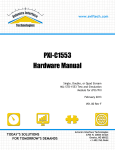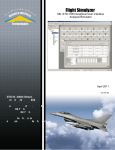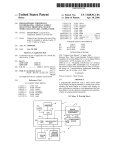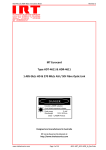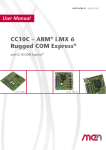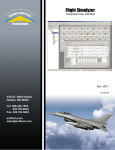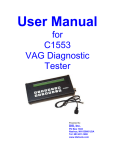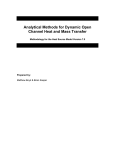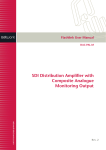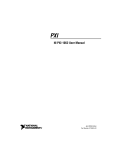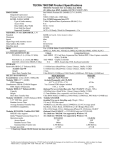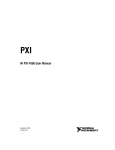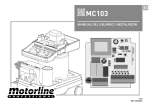Download 2 structure of the pxi
Transcript
PXI-C1553 Hardware Manual 1/2/4 Stream MIL-STD-1553 Test and Simulation Module for cPCI/PXI September 2011 V01.00 Rev. D 3703 N. 200th Street, Omaha, NE 68022 Tel: 866.246.1553 402.763.9644 Fax: 402.763.9645 aviftech.com [email protected] PXI-C1553 Hardware Manual 1/2/4 Stream MIL-STD-1553 Test and Simulation Module for cPCI/PXI V01.00 Rev. D September 2011 Avionics Interface Technologies Omaha Headquarters 3703 N. 200th Street Omaha, NE 68022 Tel: 866.246.1553 402.763.9644 Fax: 402.763.9645 Eastern Sales Office 34 Country Road East Hampstead, NH 03826 Tel: 603.378.0957 Design & Production Center 2689 Commons Boulevard Suite 201 Beavercreek, OH 45431 Tel: 937.427.1820 Fax: 937.427.1281 ext. 202 Western Territory Office 9221 E. Baseline Road Suite A-109, #432 Mesa, AZ 85212 Tel: 480.354.0142 Notice: The information provided in this document is believed to be accurate. No responsibility is assumed by AIT for its use. No license or rights are granted by implication in connection therewith. Specifications are subject to change without notice. © 2011 AIT Table of Contents ....................................................................................................1 Section 1 INTRODUCTION 1.1 General .................................................................................................................... 1 1.2 How This Manual .................................................................................................................... 4 is Organized 1.3 Applicable.................................................................................................................... 5 Documents 1.3.1 Industry Documents ...................................................................................................... 5 1.3.2 Product Specific ...................................................................................................... Documents 5 Section 2 STRUCTURE ....................................................................................................6 OF THE PXI-C1553 MODULE ....................................................................................................8 Section 3 INSTALLATION 3.1 Installing the .................................................................................................................... 8 PXI-C1553 Module 3.1.1 Installation Instructions ...................................................................................................... 8 3.1.2 Board Connectors ...................................................................................................... 8 3.2 Connections .................................................................................................................... 9 to the I/O Signals 3.2.1 Connection to the ...................................................................................................... MIL-STD-1553 Interface 9 3.2.1.1 Direct .................................................................................................................. Coupling 10 3.2.1.2 Transformer .................................................................................................................. Coupling 11 3.2.1.3 Direct .................................................................................................................. to Device (Network) Coupling 13 3.2.2 PXI-C1553 Breakout ...................................................................................................... Cables 14 3.2.3 PXI-C1553 Front ...................................................................................................... Panel Connector (J3) 17 3.2.4 PXI-C1553-EF...................................................................................................... Front Panel Connector (J3) 20 3.2.5 PXI-C1553-EF...................................................................................................... Rear I/O Connectory (J4) 22 3.2.6 PXI XJ4 Connector ...................................................................................................... 25 3.2.7 IRIG Connections ...................................................................................................... 25 3.2.8 Discrete Connections ...................................................................................................... 25 Section 4 TECHNICAL ....................................................................................................27 DATA PXI-C1553 Hardware Manual II Section 5 NOTES ....................................................................................................30 5.1 Acronyms.................................................................................................................... 30 and Abbreviations Section 6 APPENDIX A....................................................................................................32 III PXI-C1553 Hardware Manual 1 INTRODUCTION 1.1 General Document History Version Date V01.00 Rev. A October 2010 Author Description Andy Kragick/Melissa Created document Amarawardana V01.00 Rev. B December 2010 Melissa Amarawardana Format revisions V01.00 Rev. C March 2011 Melissa Amarawardana Updated connector cable specifications, Connecting the AIT Module to the Bus V01.00 Rev. D September 2011 Drew Dingman/Bill Fleissner Updated connector cable specifications This document comprises the Hardware User's Manual for the PXI-C1553 hardware module which is a member of AIT's family of advanced MIL-STD-1553 test and simulation modules. This document covers the hardware installation, the board connections, a general description of the hardware architecture, and specific electrical and physical technical data of the module. For programming information, refer to the appropriate reference documents listed in the Applicable Documents section of this manual. The PXI-C1553 modules are capable of operations in both 3.3V PCI and PCI-X systems. The modules can be used to simulate, monitor, and inject protocol errors in MIL-STD1553A/B systems and can provide up to 4 MIL-STD-1553 Dual Redundant interfaces. The Full Function variant of the module is capable of simultaneously supporting the operations of a Bus Controller (BC), Bus Monitor (BM), and up to 31 Remote Terminals (RT). The Single Function variant of the module is capable of supporting either BC operations, or BM and Monitor only RT operations, or up to 31 RT simulation operations. The Simulator Only variant of the module is capable of simultaneously supporting BC operations, up to 31 RT simulations, and up to 31 RT monitor only operations. Both Transformer and Direct MIL-STD-1553 bus coupling modes are supported. Additionally, an extended function variant of the module (PXI-C1553-EF) provides additional functions that support software programmable MIL-STD-1553 bus coupling (Transformer, Direct, Network, or Isolated) and software programmable output voltages. The modules provide an onboard IRIG B Time Decoder/Encoder in support of time synchronization with external equipment. Each module may be configured to synchronize its internal clock to an input IRIG B time signal. Additionally, the module may also be configured as an IRIG B time source capable of providing a reference time signal. The PXI-C1553 module provide 10 programmable (as input or output) discretes. Each PXI-C1553 Hardware Manual 1 discrete is capable of up to 30 V operations with an external power supply. 2 PXI-C1553 Hardware Manual Table 1.1 - PXI-C1553 Variants Part Number Description PXI-C1553-1 PXI-C1553-2 PXI-C1553-4 1, 2 and 4 channel full function interfaces for PXI Simultaneous BC, 31 RTs and BM operations IRIG-B Input/Output, 10 programmable discretes, PXI backplane triggers and timing synchronization PXI-C1553M-1 PXI-C1553M-2 PXI-C1553M-4 1, 2 and 4 channel single function interfaces for PXI BC or 31 RTs or BM and 31 RT monitor only operations IRIG-B Input/Output, 10 programmable discretes, PXI backplane triggers and timing synchronization PXI-C1553S-1 PXI-C1553S-2 PXI-C1553S-3 1, 2 and 4 channel simulate only interfaces for PXI BC or 31 RTs and 31 RT monitor only operations IRIG-B Input/Output, 10 programmable discretes, PXI backplane triggers and timing synchronization PXI-C1553-EF-1 PXI-C1553-EF -2 PXI-C1553-EF -4 1, 2 and 4 channel extended full function interfaces for PXI Simultaneous BC, 31 RTs and BM operations Programmable bus coupling/output voltage IRIG-B Input/Output, 10 programmable discretes, PXI backplane triggers and timing synchronization PXI-C1553M-EF-1 PXI-C1553M-EF-2 PXI-C1553M-EF-4 1, 2 and 4 channel single function interfaces for PXI BC or 31 RTs or BM and 31 RT monitor only operations Programmable bus coupling/output voltage IRIG-B Input/Output, 10 programmable discretes, PXI backplane triggers and timing synchronization PXI-C1553S-EF -1 PXI-C1553S-EF -2 PXI-C1553S-EF -3 1, 2 and 4 channel simulate only interfaces for PXI BC or 31 RTs and 31 RT monitor only operations Programmable bus coupling/output voltage IRIG-B Input/Output, 10 programmable discretes, PXI backplane triggers and timing synchronization PXI-C1553 Hardware Manual 3 1.2 How This Manual is Organized This manual is comprised of the following sections: Section 1, INTRODUCTION, contains an overview of this manual. Section 2, STRUCTURE OF THE PXI-C1553, describes the physical hardware interfaces on the PXI-C1553 using a block diagram and a description of each main component. Section 3, INSTALLATION, describes the steps required to install the PXI-C1553 device and to connect the device to other external interfaces, including the MIL-STD-1553 databus, IRIG-B, and discretes. Section 4, TECHNICAL DATA, describes the technical specification of the PXIC1553. Section 5, NOTES, contains a list of acronyms and abbreviations used in this manual. 4 PXI-C1553 Hardware Manual 1.3 Applicable Documents The following documents shall be considered to be a part of this document to the extent that they are referenced herein. In the event of conflict between the documents referenced and the contents of this document, the contents of this document shall have precedence. 1.3.1 Industry Documents MIL-STD-1553B, Department of Defense Interface Standard for Digital Time Division Command/Response Multiplex Data Bus, Notice 1-4, January 1996 MIL-STD-1760, 1 August 2003, Department of Defense Interface Standard for Aircraft/Store Electrical Interconnection System PICMG 2.0 R3.0 CompactPCI Specification PXI Hardware Specification, Revision 2.2, PXI Systems Alliance PXI Hardware Specification, Revision 2.2 ECN 1, PXI Systems Alliance PCI Local Bus Specification, R2.3 &3.0 PCI-to-PCI Bridge Architecture Specification, Revision 1.1 1.3.2 Product Specific Documents AIT MIL-STD-1553 Getting Started Manual, provides detailed instructions to assist first time users of AIT MIL-STD-1553 interface modules with software installation, hardware setup, and starting a sample project. AIT MIL-STD-1553 Object Wrapper Library Reference Manual, provides a detailed description of the high level object oriented programming interface between host application programs and the PXI-C1553. PXI-C1553 Hardware Manual 5 2 STRUCTURE OF THE PXI-C1553 MODULE The structure of the PXI-C1553 module is shown in Figure 2 below. Figure 2 - Structure of the PXI-C1553 6 PXI-C1553 Hardware Manual The primary components of the PXI-C1553 are: PCI to PCI Bridge This bridge allows multiple devices (namely the PMC1553 and PXI Trigger/IO controller) on the on-card PCI bus. This bus runs at 33.333 MHz, whereas the CompactPCI backplane may run at 66 MHz or 33 MHz. MIL-STD-1553 Core/PowerPC FPGA The MIL-STD-1553 Core and PowerPC is implemented in a Xilinx Virtex 4. The PowerPC operates at 250MHz and is capable of hosting time critical user application functions. The MIL-STD-1553 Core supports simultaneous Bus Controller, Bus Monitor and Remote Terminal (up to 31) functions on each of the available four bus interfaces. Full error injection and error detection capabilities are provided. SDRAM Two 128MB banks of SDRAM provide storage for bus transmit & receive buffers and for PowerPC program and data stores. MIL-STD-1553 Transceivers and Coupling circuits The Transceivers and Coupling circuits provide both transformer and direct coupling access to all four dual redundant bus interfaces. IRIG-B Encoder/Decoder The IRIG-B Decoder allows the PXI-C1553 module to synchronize its time tagging clock source to an external IRIG-B time source. The IRIG-B Encoder allows the PXI-C1553 module to output an IRIG-B time signal derived from the modules onboard time tagging clock so that external equipment may be synchronized to the module. This IRIG time may be reset by the PXI_STAR signal if configured through software to do so. Discrete Drivers and Buffers Ten discrete signals are provided, each independently programmable as an input or output. In support of MIL-STD-1760 applications, outputs can be used to driver up to +30V signals with the help of an external power supply and inputs can tolerate up to +30V signals. The variable output voltage MIL-STD-1553 transceivers provide for the generation of variable voltage bus signals. The output voltage is controlled by an software programmable control voltage via the digital potentiometers. When direct bus coupling is used, the output voltage can be varied between 140 mVp-p and 7Vp-p (measured with 36 Ohm load). When transformer bus coupling is used, the output voltage can be varied between 410 mVp-p and 19Vp-p (measured with 73 Ohm load). The onboard coupling circuits allow software to control the bus coupling mode of each of the four channels independently, and set them in either direct, transformer, network or isolated mode. For definitions of these modes, see Table 3.2.4-I. PXI-C1553 Hardware Manual 7 3 INSTALLATION 3.1 Installing the PXI-C1553 Module The PXI-C1553 features full PCI 'plug-and-play' capability. There are no jumpers or switches on the board which have to be modified by the user. Note: We recommend that you use a wrist strap for any installations. If there is no wrist wrap available, then touch a metal plate on your system to ground yourself and discharge any static electricity during the installation work. The following instructions describe how to install the PXI-C1553. Follow the instructions carefully to avoid any damage on the device. 3.1.1 Installation Instructions To Install the PXI-C1553 Module: 3.1.2 1. Shut down your system and all peripheral devices. Unplug the power cord from the wall outlet. (Inserting or removing modules with power applied may result in damage to the module devices.) 2. Remove any chassis panel covers necessary to gain access to a PXI/ CompactPCI peripheral slot. 3. Place the PXI-C1553 module into an open slot in your chassis. 4. Screw the PXI-C1553 board into the top rail with the captive screw at the top of the faceplate. 5. Connect system with power source and turn on the power to your system. Board Connectors The PXI-C1553, provides user access to the MIL-STD-1553 Bus signals, Discrete I/O signals and IRIG-B Input/Output Signals at the front panel 68-pin VHDCI (J4) connector. 8 PXI-C1553 Hardware Manual 3.2 Connections to the I/O Signals 3.2.1 Connection to the MIL-STD-1553 Interface The MIL-STD-1553 bus interface of the PXI-C1553 (non -EF) supports up to four dual redundant 1553 channels. For each channel both transformer coupled and direct coupled connections are provided. The transformer coupled signals can be connected directly to a stub of a MIL-STD-1553 coupler. The direct coupled connections can be connected directly to the MIL-STD-1553 bus. Both the direct and transformer coupled signals are provided at the front panel connector (J3). Additionally, the transformer coupled signals are provided at the rear I/O connector (J4). The MIL-STD-1553 bus interface of the PXI-C1553-EF also supports up to four dual redundant 1553 channels. For each channel one of four bus coupling modes can be independently programmed as described in the table below. The MIL-STD-1553 bus signals of the PXI-C1553-EF modules are only provided at the front panel connector (J3). Table 3.2.1 - Bus Coupling Modes Coupling Mode Description Direct Bus signal provided at front panel is direct coupled and can be connected directly to the 1553 bus Transformer Bus signal provided at the front panel is transformer coupled and can be connected directly to a stub of a bus coupler Network A properly terminated bus network is simulated on the PXI-C1553-EF card and a bus stub is provided at the front panel connector, the bus signal at the front panel can be connected directly to a transformer coupled MILSTD-1553 device Isolated No bus signal is provided at the front panel, the front panel bus signal pins are disconnected from the internal circuitry of the PXI-C1553-EF module The MIL-STD-1553 specification clearly defines the process of coupling subsystems to the bus. This connection, called a stub, has two coupling options: direct coupled and transformer coupled. In addition to these two methods of connecting to the bus, a direct to device (network) coupling configuration is also an option. All three methods are described in this section. The Flight Director bus analyzer software allows the user to select isolated, transformer, direct or network coupling, through the system setup controls. Use of an AIT module without the Flight Director software is accomplished with library setup calls. PXI-C1553 Hardware Manual 9 3.2.1.1 Direct Coupling Direct coupling connects the subsystem/terminal device directly to the bus and can only be used in connections under one foot in length. Since a direct coupled stub provides only limited isolation in the event of a device (subsystem or terminal) short, transformer coupling is normally the recommended method of connecting to the bus. Figure 3.2.1.1 - Direct Coupling 10 PXI-C1553 Hardware Manual 3.2.1.2 Transformer Coupling Transformer coupling utilizes a bus coupler that contains an isolation transformer and isolation resistors. Transformer coupling extends the stub length to 20 feet and provides electrical isolation, better impedance matching and higher noise rejection characteristics than direct coupling. The electrical isolation prevents a terminal fault or stub impedance mismatch from affecting bus performance. Figure 3.2.1.2-I - Bus Coupler Connecting to the bus using transformer coupling requires a coupler for each subsystem/ terminal device and proper termination on the bus. Figure 3.2.1.2-II - Terminal Device Connection Cables PXI-C1553 Hardware Manual 11 Figure 3.2.1.2-III - Transformer Coupling 12 PXI-C1553 Hardware Manual 3.2.1.3 Direct to Device (Network) Coupling Direct to Device (Network) coupling is an option with AIT modules. The AIT design includes onboard bus network circuitry that is software selectable. This allows the user to connect directly to a single terminal device without the need for any bus coupling. The network coupling mode, selected by the user via software controls, provides a terminated MILbus network simulation on the AIT module for direct connection between the AIT module, software, and the terminal under test. Figure 3.2.1.3 - Direct to Device (Network) Coupling PXI-C1553 Hardware Manual 13 3.2.2 PXI-C1553 Breakout Cables The PXI-C1553 and PXI-C1553-EF modules are delivered with one of three cable assemblies, which provide only transformer coupled outputs for the non -EF, and software selectable coupling for the -EF: A single channel card is delivered with one break out cable Part Number CBLVHDCI-1553-1. It includes two Twinax BNC connectors for each of the MILSTD-1553 bus connections. A dual channel card is delivered with one break out cable Part Number CBLVHDCI-1553-2. It includes four Twinax BNC connectors for each of the MILSTD-1553 bus connections. A quad channel card is delivered with one break out cable Part Number CBLVHDCI-1553-4. It includes eight Twinax BNC connectors for each of the MILSTD-1553 bus connections, and one 15 pin standard DSUB breakout connector to provide access to the IRIG, Digital I/O (DIO), and the Voltage I/O (VIO) control signal. Figure 3.2.2 - PXI-C1553 Cable Assemblies AIT#CBL-VHDCI-1553-1 Delivered with the PXI-C1553-1 14 PXI-C1553 Hardware Manual AIT#CBL-VHDCI-1553-2 Delivered with the PXI-C1553-2 AIT#CBL-VHDCI-1553-4 Delivered with the PXI-C1553-4 If the customer application requires IRIG or other signals for a single or dual channel card (normally shipped standard only with a quad channel card), customers may order the quad channel cable from AIT's Price List. For assistance, contact your AIT Sales Engineer or call AIT at +1 402.763.9644. AIT will make any custom cable configurations and/or length required. PXI-C1553 Hardware Manual 15 Table 3.2.2 - Breakout Cable Pinout Pin J1-J8 BNCs J1 J1 J2 J2 J3 J3 J4 J4 J5 J5 J6 J6 J7 J7 J8 J8 D-Sub J9-1 J9-2 J9-3 J9-4 J9-5 J9-6 J9-7 J9-8 J9-9 J9-10 J9-11 J9-12 J9-13 J9-14 J9-15 16 PXI-C1553 Hardware Manual Signal Name MIL bus twinax BNC connections CHA_1A_XC+ CHA_1A_XCCHA_1B_XC+ CHA_1B_XCCHA_2A_XC+ CHA_2A_XCCHA_2B_XC+ CHA_2B_XCCHA_3A_XC+ CHA_3A_XCCHA_3B_XC+ CHA_3B_XCCHA_4A_XC+ CHA_4A_XCCHA_4B_XC+ CHA_4B_XC15 pin Standard VIO-IN IRIG-OUT IRIG-IN GND DIO9 DIO8 DIO7 DIO6 DIO5 DIO4 DIO3 DIO2 DIO1 DIO0 GND 3.2.3 PXI-C1553 Front Panel Connector (J3) For applications not using the break out cables provided, the PXI-C1553 (non -EF) front panel connector (J3) is a 68-pin VHDCI connector that provides access to the transformer coupled and direct coupled MIL-STD-1553 databus signals (four redundant channels), IRIG-B Input/Output signals, and the Discrete I/O signals. Pinouts for the PXI-C1553 are given below. PXI-C1553 Hardware Manual 17 Table 3.2.3-I - PXI-C1553 Front Panel Connector (J3) Pin Assignment 18 Pin No. Signal Direction Pin No. Signal Direction 1 VIO_IN Input 35 GND Bidir. 2 IRIG_OUT Output 36 GND Bidir. 3 IRIG_IN Input 37 GND Bidir. 4 GND 38 GND 5 DIO9 Bidir. 39 GND Bidir. 6 DIO8 Bidir. 40 GND Bidir. 7 DIO7 Bidir. 41 GND Bidir. 8 DIO6 Bidir. 42 GND Bidir. 9 DIO5 Bidir. 43 GND Bidir. 10 DIO4 Bidir. 44 GND Bidir. 11 DIO3 Bidir. 45 GND Bidir. 12 DIO2 Bidir. 46 GND Bidir. 13 DIO1 Bidir. 47 GND Bidir. 14 DIO0 Bidir. 48 GND Bidir. 15 GND 49 GND . 16 CHA_4B_DC+ Bidir. 50 CHA_4B_DC- Bidir. 17 CHA_4B_XC+ Bidir. 51 CHA_4B_XC- Bidir. 18 CHA_4A_DC+ Bidir. 52 CHA_4A_DC- Bidir. 19 CHA_4A_XC+ Bidir. 53 CHA_4A_XC- Bidir. 20 GND 54 GND 21 CHA_3B_DC+ Bidir. 55 CHA_3B_DC- Bidir. 22 CHA_3B_XC+ Bidir. 56 CHA_3B_XC- Bidir. 23 CHA_3A_DC+ Bidir. 57 CHA_3A_DC- Bidir. 24 CHA_3A_XC+ Bidir. 58 CHA_3A_XC- Bidir. 25 GND 59 GND 26 CHA_2B_DC+ Bidir. 60 CHA_2B_DC- Bidir. 27 CHA_2B_XC+ Bidir. 61 CHA_2B_XC- Bidir. 28 CHA_2A_DC+ Bidir. 62 CHA_2A_DC- Bidir. 29 CHA_2A_XC+ IN 63 CHA_2A_XC- Bidir. 30 GND 64 GND 31 CHA_1B_DC+ Bidir. 65 CHA_1B_DC- Bidir. 32 CHA_1B_XC+ Bidir. 66 CHA_1B_XC- Bidir. 33 CHA_1A_DC+ Bidir. 67 CHA_1A_DC- Bidir. 34 CHA_1A_XC+ Bidir. 68 CHA_1A_XC- Bidir. PXI-C1553 Hardware Manual Table 3.2.3-II - Signal Descriptions Signal CHA_xB_DC CHA_xA_DC CHA_xB_XC CHA_xA_XC IRIG_OUT IRIG_IN DIOx VIO_IN NC GND Description MIL-STD-1553 Bus B Direct Coupled Interface Signal MIL-STD-1553 Bus A Direct Coupled Interface Signal MIL-STD-1553 Bus B Transformer Coupled Interface Signal MIL-STD-1553 Bus A Transformer Coupled Interface Signal IRIG-B Output Signal IRIG-B Input Signal Discrete I/O Input/Output Discrete I/O Output Reference Voltage Input No Connection Ground PXI-C1553 Hardware Manual 19 3.2.4 PXI-C1553-EF Front Panel Connector (J3) For applications not using the break out cables provided, the PXI-C1553-EF (Extended Functionality), the pinout for the PXI-C1553-EF front panel connector, are different than those for the PXI-C1553 due to the fact that the PXI-C1553-EF supports multiple software programmable bus coupling modes on the same front panel pins. Pinouts for the PXI-C1553EF are given below. 20 PXI-C1553 Hardware Manual Table 3.2.4 - PXI-C1553-EF Front Panel Connector (J3) Pin Assignment Pin No. Signal Direction Pin No. Signal Direction 1 VIO_IN Input 35 GND Bidir. 2 IRIG_OUT Output 36 GND Bidir. 3 IRIG_IN Input 37 GND Bidir. 4 GND 38 GND Bidir. 5 DIO9 Bidir. 39 GND Bidir. 6 DIO8 Bidir. 40 GND Bidir. 7 DIO7 Bidir. 41 GND Bidir. 8 DIO6 Bidir. 42 GND Bidir. 9 DIO5 Bidir. 43 GND Bidir. 10 DIO4 Bidir. 44 GND Bidir. 11 DIO3 Bidir. 45 GND Bidir. 12 DIO2 Bidir. 46 GND Bidir. 13 DIO1 Bidir. 47 GND Bidir. 14 DIO0 Bidir. 48 GND Bidir. 15 GND Bidir. 49 GND Bidir. 16 N.C. 17 CHA_4B+ 50 N.C. 51 CHA_4B- 18 N.C. 52 N.C. 19 CHA_4A+ Bidir. 53 CHA_4A- Bidir. 20 GND Bidir. 54 GND Bidir. 21 N.C. 55 N.C. 22 CHA_3B+ Bidir. 56 CHA_3B- 23 N.C. Bidir. 57 N.C. 24 CHA_3A+ Bidir. 58 CHA_3A- Bidir. 25 GND Bidir. 59 GND Bidir. 26 N.C. 60 N.C. 27 CHA_2B+ Bidir. 61 CHA_2B- 28 N.C. Bidir. 62 N.C. 29 CHA_2A+ Bidir. 63 CHA_2A- Bidir. 30 GND Bidir. 64 GND Bidir. 31 N.C. 65 N.C. 32 CHA_1B+ 66 CHA_1B- 33 N.C. 67 N.C. 34 CHA_1A+ 68 CHA_1A- Bidir. Bidir. Bidir. Bidir. Bidir. Bidir. Bidir. Bidir. PXI-C1553 Hardware Manual 21 3.2.5 PXI-C1553-EF Rear I/O Connectory (J4) The rear (J4) connector of the PXI-C1553 or PXI-C1553-EF is a DIN64 male connector that provides access to the Bus signals, IRIG-B signals and the Discrete I/O signals. 22 PXI-C1553 Hardware Manual Table 3.2.5 - PXI-C1553-EF Rear I/O Connector (J4) Pin Assignments J4 (Row C) Pin# Signal J4 (Row A) Pin# J4 (Row A) 1 CHA_1A_XC- 1 CHA_1B_XC- 2 CHA_1A_XC+ 2 CHA_1B_XC+ 3 DIO3 3 CHA_3A_XC- 4 DIO4 4 CHA_3A_XC+ 5 DIO5 5 CHA_4A_XC- 6 DIO6 6 CHA_4A_XC+ 7 DIO7 7 CHA_3B_XC- 8 DIO8 8 NC 9 DIO9 9 NC 10 NC 10 CHA_4B_XC- 11 NC 11 NC 12 NC 12 NC 13 NC 13 VIO_IN 14 CHA_3B_XC+ 14 NC 15 NC 15 IRIG_IN 16 NC 16 IRIG_OUT 17 NC 17 CHA_4B_XC+ 18 DIO2 18 NC 19 DIO1 19 NC 20 DIO0 20 NC 21 NC 21 NC 22 NC 22 NC 23 NC 23 NC 24 NC 24 NC 25 NC 25 NC 26 NC 26 NC 27 NC 27 NC 28 NC 28 NC 29 NC 29 NC 30 NC 30 NC 31 CHA_2A_XC- 31 CHA_2B_XC- PXI-C1553 Hardware Manual 23 32 24 PXI-C1553 Hardware Manual CHA_2A_XC+ 32 CHA_2B_XC+ 3.2.6 PXI XJ4 Connector Table 3.2.6 - XJ4 Connector 3.2.7 Pin Z A B C D E F 1 GND GA4 GA3 GA2 GA1 GA0 GND 2 GND 3 GND 4 GND 5 GND PXI TRIG3 PXI TRIG4 6 GND PXI TRIG2 GND 7 GND PXI TRIG1 PXI TRIG0 8 GND RSV GND GND GND GND GND PXI TRIG5 RSV GND PXI TRIG6 GND PXI STAR PXI CLK10 GND GND PXI TRIG7 GND PXI LBL6 PXI LBR6 GND IRIG Connections The IRIG_IN and IRIG_OUT signals of the PCI-C1553 and PCI-C1553-EF are provided at both the front panel connector (J4). The IRIG_IN and IRIG_OUT signals shall be connected depending on the time tagging method used as described below: Single module with no external IRIG source: No connections required Multiple modules with no common synchronization requirement: No connections required Single or multiple modules with external IRIG source: Connect IRIG source to IRIG_IN and GND of all modules Multiple AIT modules with no external IRIG source: Connect the IRIG_OUT signal and the GND of the module you have chosen as the time master to all IRIG_IN and GND signals of all boards (including the master's) 3.2.8 Discrete Connections Ten Discrete I/O signals are provided at the front panel connector (J4). Each discrete can be operated as an output or an input. The discrete outputs can be configured (in software) as open-collector (current sink), emitter follower (current source) or a TTL-like output. In the case of the emitter follower configuration VIO_IN may be provided from an external source and used to externally set the high output voltage level. If VIO_IN is not provided externally, then the onboard +5V supply is used. External pull-up or pull-down resistors must be selected to ensure that the output load does not exceed +/- 100mA. An output voltage decrease will be seen as loads increase as described below. PXI-C1553 Hardware Manual 25 Table 3.2.8 - Output Voltage Logic '1' output powered by onboard +5V VIO Load Output Voltage 10mA 4.0V 70mA 3.5V 100mA 3.0V Logic '0' output powered by onboard +5V VIO Load Output Voltage any load up to +/-100mA 0.2V Logic '1' output powered by externally provided +30V at VIO_IN Load Output Voltage 10mA 28V 100mA 27V Logic '0' output powered by externally provided +30V at VIO_IN Load Output Voltage any load up to +/-100mA 0.2V The discrete input Logic '1' minimum voltage is +2.5V. The input Logic '0' maximum voltage is +0.8V. All discrete inputs are protected up to +30V. Note: An optional onboard pull-up resistor to onboard 5V supply or the externally provided VIO_IN may be provided. Please consult factory for details. 26 PXI-C1553 Hardware Manual 4 TECHNICAL DATA PCI Interface: 32-bit/33 MHz PCI plus PXI Trigger Bus, PXI System Clock, and PXI Star Trigger Form Factor: 3U Hybrid Slot Compatible PXI Module Memory: 256 Mbyte DDR2 SDRAM (128MB for channel data, 128MB for onboard processor) MIL-STD-1553 Channels: PXI-C1553-EF: Up to 4 Dual Redundant MIL-STD-1553 channels with programmable coupling and output voltage are supported. PXI-C1553: Up to 4 Dual Redundant MIL-STD-1553 channels with both transformer and direct coupling modes are supported. Each channel independently capable of simultaneous Bus Controller, Bus Monitor, and Remote Terminal (up to 31) simulation. MIL-STD-1553 Bus Controller: Major Framing, Minor Framing, and Acyclic message transfer scheduling Inter-message Gap Scheduling Full error injection capabilities in support of AS4112 RT Validation Testing Automatic Bus Retries Full Mode Code generation support MIL-STD-1553 Remote Terminals: Simultaneously supports 31 RTs Programmable Response Times (250 ns increments) Full Error Injection Intelligent Mode Code responses Passive, receive only monitor mode operations MIL-STD-1553 Bus Monitor: Chronologically time tags and stores all bus traffic Error detection and notifications including detection of Gap and Response time violations, low bit/word counts, parity errors, sync errors, and status work exceptions Complex Triggering and Filtering Programmable Pre/Post Trigger storage MIL-STD-1553 Replay: Replay of stored bus monitor data Replay can be synchronized across channels/modules Time Tagging: 46-bit IRIG time tag (IRIG time + microseconds since start of second) IRIG Input: Resolution: 1 us Width: 14 BCD digits (400 days) Signal Type: Single ended analog Signal Waveform: Amplitude modulated sine wave or PXI-C1553 Hardware Manual 27 square wave IRIG Output: Discretes: 28 Modulation Ratio: 3:1 to 6:1 Input Amplitude: 0.2Vpp to 3Vpp Input Impedance: > 3k Ohm Coupling: AC Coupled Time Jitter: +/-5nS (typical, module to module) depending on input signal quality Lock time: 1 to 5 seconds depending on input signal quality Signal Type: Single ended analog Signal Waveform: Amplitude modulated sine wave Modulation Ratio: 3:1 Output Amplitude: +/- 1.5 volts Output Impedance: 1.3 Ohms typ. (designed for 50 Ohm load) 10 Fully programmable (as input or output) discrete signals Inputs: Min. Logic '1': +2.5V Max. Logic '0': +0.8V Tolerant of up to +30V input Outputs: Software configurable as open collector or emitter followers Maximum load +/-100mA Emitter Follower configuration capable of providing up to +5V signal without external (VIO_IN) supply or up to +30V signal with external (VIO_IN) supply. Connectors: J1 XJ4 J4 Dimensions: 3U CompactPCI (100mm x 160mm) Weight: < 0.6 lbs. Supply Voltages: +3.3V +/- 5% +5V +/- 5% +12V +/- 5% -12V +/- 5% PXI-C1553 Hardware Manual Power (Operating): Temperature: Humidity: Total Power: Voltage Current +3.3V TBD +5V TBD +12V TBD -12V TBD Operating: 0 °C to +70° C Storage: -40° C to +85° C 0 to 95% (non condensing) PXI-C1553 Hardware Manual 29 5 NOTES 5.1 Acronyms and Abbreviations ADC AFDX ALBI ANSI ARINC ARM BC BIP BIU CM cPCI CPLD CPU DAC DC-DC DIP DMA DRAM DSUB EDO EEPROM EPROM FIFO FLASH FPGA GND IEEE IRIG IRIG-B I/O LCA LED MIL-STD OWL PC PCI PCIe PMC PROM 30 Analog to Digital Converter Avionics Full Duplex Databus Local Bus Interface American National Standards Institute Aeronautical Radio, Incorporated Advanced RISC Machine Bus Controller Bus Interface Processor Bus Interface Unit Chronological Bus Monitor Compact PCI Coupled Central Processing Unit Digital to Analog Converter Direct Current to Direct Current (power conversion) Data Interface Processor Direct Memory Access Dynamic Random Access Memory D-Subminiature Enhanced Data Output Electrically Erasable and Programmable Read Only Memory Erasable Programmable Read Only Memory First in/First out Page oriented electrical erasable and programmable memory Field Programmable Gate Array Ground Institute of Electric and Electronic Engineers Inter Range Instrumentations Group Inter Range Instrumentations Group Time code Format Type B Input/Output Logic Cell Array (XILINX - Programmable Gate Array) Light-emitting Diode Military Standard Object Wrapper Library Personal Computer Peripheral Component Interconnect Peripheral Component Interconnect Express PCI Mezzanine Card Programmable Read Only Memory PXI-C1553 Hardware Manual PSC PXI PXIe RAM RISC RMW RS-232 RT RTPTP RXD SDK SIMM SRAM SSRAM TBD TCP TTL TXD UART USB VME VME64 VXI XMC PCI and System Controller PCI Extensions for Instrumentation PCI Extensions for Instrumentation Express Random Access Memory Reduced Instruction Set Computer Read-Modify-Write Recommended Standard No.232 (US-Norm) Remote Terminal Remote Terminal Production Test Plan Received Data AIT's Software Development Kit Single Inline Memory Module Static Random Access Memory Synchronous Static Random Access Memory To be determined Time Code Processor Transistor-Transistor Logic Transmitted Data Universal Asynchronous Receiver and Transmitter Universal Serial Bus VERSAmodule Eurocard VME 64bit extension VME Extensions for Instrumentation PCI Express Mezzanine Card PXI-C1553 Hardware Manual 31 6 APPENDIX A Avionics Interface Technologies Product Information for People’s Republic of China This document provides product information as required by the People’s Republic of China Electronic Industry Standard SJ/T11364–2006, Marking for Control of Pollution Caused by Electronic Information Products. Table 1 lists toxic or hazardous substances or elements contained in Avionics Interface Technologies (AIT) electronic information products (EIPs), including subassemblies, that exceed limits specified in SJ/T11363–2006. Table 1 - Toxic or Hazardous Substances or Elements in Product Toxic or hazardous Substances or Elements Lea d (Pb) Mercur y (Hg) Cadmiu m (Cd) Hexavale nt Chronium (Cr6+) PXI 1553 4 Channel Carrier for PMC 1553 X O O O O O Hardware Standoff HEX 5mm x 10mm M2.5 (Aluminum Clear Iridite finish) O O O O O O Hardware Screw Metric M2.5 x 5mm O O O O O O Hardware Faceplate Overlay O O O O O O Hardware Face Plate(PXI-1553) O O O O O O PMC 1553 Channel Conduction Cooled Parts List X O O O O O Component Name Polybrominate Polybrominat d Biphenyls ed Diphenyl (PBB) Ethers (PBDE) Product Marking Explanations In accordance with the requirements specified in SJ/T11364–2006, all AIT EIPs sold in the People’s Republic of China are marked with a pollution control marking. The following marking applies to AIT products. 32 PXI-C1553 Hardware Manual This marking indicates that some homogeneous substance within the EIP contains toxic or hazardous substances or elements above the requirements listed in SJ/T11363–2006. These substances are identified in Table 1. The size or function of some products may prevent them from being directly marked. These products still meet SJ/T11364–2006 requirements, and their marking information is covered by this document. Environmentally Friendly Use Period The number in the marking, shown as 40 in the illustration above, refers to the EIP’s environmentally friendly use period (EFUP). The EFUP is the number of years from the date of manufacture that toxic or hazardous substances or elements contained in EIPs will not leak or mutate under the normal operating conditions described in the EIP user documentation, resulting in any environmental pollution, bodily injury, or damage to assets. Note: Except as expressly stated herein and as required under mandatory provisions of regulations of the People’s Republic of China, Avionics Interface Technologies makes no representation or warranty of any kind, expressed or implied, with respect to the EFUP and expressly disclaims any representations or warranties, expressed or implied, with respect to the EFUP. Original Equipment Manufactured (OEM) EIPs SJ/T11364–2006 specifies that OEM EIPs shipped by AIT should include hazardous substance information and EFUP markings. Table 1 applies to products that do not supply OEM product information. Manufacture Date Contact your local sales representative to obtain the manufacture date of your product. Waste Electrical and Electronic Equipment (WEEE) EU Customers: At the end of the product life cycle, all products must be sent to a WEEE recycling center. For more information about WEEE recycling centers, National Instruments WEEE initiatives and compliance with WEEE Directive 2002/96/EC on Waste Electrical and Electronic Equipment, visit ni.com/environment/weee.htm PXI-C1553 Hardware Manual 33







































